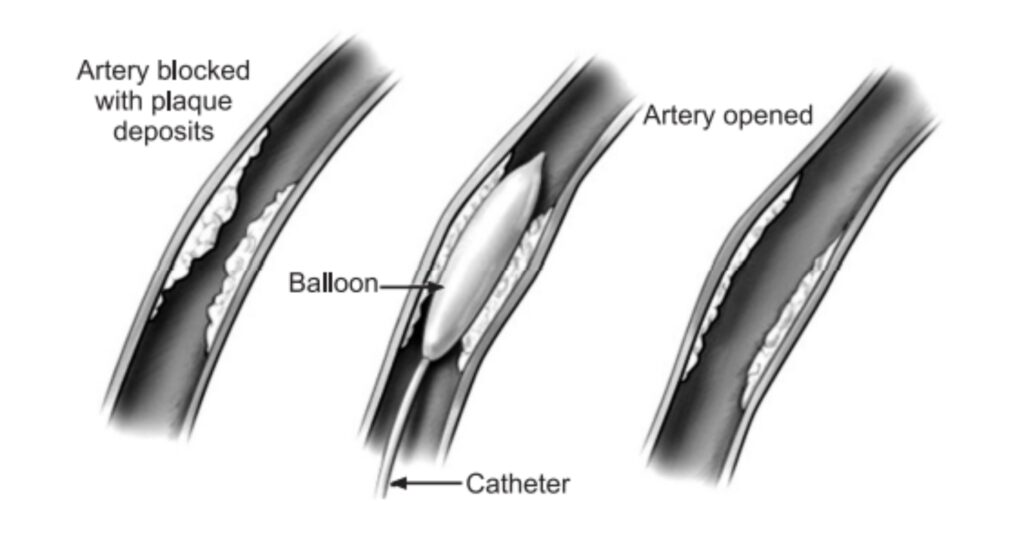Diagnosis Of Atherosclerosis
Physicians may be able to make a diagnosis of atherosclerosis during a physical exam by means of a stethoscope and gentle probing of the arteries with the hand (palpation) to find signs of narrowed, enlarged or hardened arteries, including: A weak or absent pulse below the narrowed area of artery. Decreased blood pressure in an affected limb. Whooshing sounds (bruits) over arteries, heard using a stethoscope. Signs of a pulsating bulge (aneurysm) in abdomen or behind knee. Evidence of poor wound healing in the area where blood flow is restricted. Depending on the results of the physical exam, more
Diagnostic Tests Given For Diagnosis Of Atherosclerosis
- Blood tests: Blood tests can detect increased levels of cholesterol and blood
sugar that may increase the risk of atherosclerosis. - Doppler ultrasound: It is a special ultrasound device (Doppler ultrasound) used to measure blood pressure at various points along arm or leg. These measurements can help doctor to measure the degree of any blockages, as well as the speed of blood flow in arteries.
- Ankle-brachial index: This test can reveal the atherosclerosis in the arteries in legs and feet. Doctor may compare the blood pressure in ankle with the blood pressure in arm. This is known as the ankle brachial index. An abnormal difference may indicate peripheral vascular disease, which is usually caused by atherosclerosis.
More definite number of tests are:
- Electrocardiography (ECG): An electrocardiogram measures the electrical
activity of heart. This test can measure how well heart is functioning and can often
detect the presence of heart disease. - Stress test: A stress test, also called an exercise stress test, is used to gather information about how well heart works during physical activity. Because exercise makes heart pump harder and faster than it does during most daily activities, an exercise stress test can reveal problems within heart that might not be noticeable otherwise. An exercise stress test usually involves walking on a treadmill or riding a stationary bike while heart rhythm, blood pressure and breathing are monitored.
- Cardiac catheterization and angiogram: This test can show if coronary arteries are narrowed or blocked. A liquid dye is injected into the arteries of heart through a long, thin tube (catheter) that is fed through an artery, usually in leg, to the arteries in heart. As the dye fills arteries, the arteries become visible on Xray, revealing areas of blockage.
- Ultrasound: An ultrasound scanner uses sound waves to build up a picture of the inside of body. This can be used to measure blood pressure at different points in body. Any variation in pressure could point to the site of a blockage in arteries. Ultrasound tests can also be used to study the larger arteries.
- Computerized tomography scan: A computerized tomography (CT) scan takes a series of X-ray images and uses a computer to assemble them into a more detailed three-dimensional image. It can often detect narrowing or hardening in the larger arteries.
Treatment For Atherosclerosis
Lifestyle changes: The changes will focus on weight management, physical
activity and a healthy diet. Doctor may recommend eating foods high in soluble
fiber and limiting intake of saturated fats, sodium and alcohol.
Medication prescribed: The medications may be for Treatment of Atherosclerosis
- To prevent the deposition of plaque or blood clots using antiplatelet agents or Thrombolytic agents.
- To lower cholesterol such as statins.
- To lower blood pressure such as
Angiotensin-converting enzyme (ACE) inhibitors, Diuretics (Water pills) Surgery: Severe cases of atherosclerosis may be treated by surgical procedures, such
as angioplasty or coronary artery bypass grafting (CABG). Angioplasty involves expanding the artery and opening the blockage, so that the blood can flow through properly again. CABG is another form of surgery that can improve blood flow to the heart by using arteries from other parts of the body to bypass a narrowed coronary artery.
Angioplasty and stent placement in the Treatment of Atherosclerosis
Angioplasty is a procedure in which a tiny device is inserted into narrowed blood vessels that supply blood to the heart. This device widens the arteries and increases
blood flow. Balloon angioplasty, also known as percutaneous transluminal coronary angioplasty (PTCA), uses a small, thin tube (called a catheter) with a tiny balloon at its
tip. The tube is inserted into the bloodstream through a large vessel in the arm or leg. By watching the progress of the tube on an X-ray, the cardiologist guides the tube into the heart, where it is inserted into a narrowed coronary artery. The tiny balloon is then inflated to widen the narrowed area.
During most of these procedures, cardiologists also insert a metal wire frame that serves as a scaffolding to help keep the artery open. This device is called a stent. A blocked artery is less likely to close up if a stent is in place. There are two types of stents:
- Bare metal stents
- Drug coated stents Endarterectomy
In some cases, fatty deposits must be surgically removed from the walls of a narrowed artery. When the procedure is done on arteries in the neck (the carotid arteries), it is called a carotid endarterectomy.
Bypass surgery: In this, a graft bypass may be created using a vessel from another part of body or a tube made of synthetic fabric. This allows blood to flow around the blocked or narrowed artery. which is a well known Treatment for Atherosclerosis
| Treatment For | Drugs Used |
|---|---|
| Statins to lower bad cholesterol (LDL) | Lovastatin, Simvastatin, Pravastatin, Fluvastatin, Atorvastatin, Rosuvastatin |
| Fibrates to reduce Triglycerides | Gemfibrozil, Fenofibrate |
| Reducing triglycerides and LDL. It also increases HDL. | Nictoinic acid. |
| Other drugs for atherosclerosis | Cholestyramine, Colestipol, Colesevelam |
Read More: Atherosclerosis | Causes |Pathophysiology |Symptoms| Pronunciation

